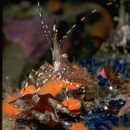Look Alikes
provided by Invertebrates of the Salish Sea
How to Distinguish from Similar Species: Pandalus stenolepis has 3-5 pairs of small lateral spines on the telson and the outer margin of its antennal scale is concave. Although it has reddish stripes on the sides of its abdomen, they angle upward posteriorly rather than downward.
- license
- cc-by-nc-sa
- copyright
- Rosario Beach Marine Laboratory
Habitat
provided by Invertebrates of the Salish Sea
Rocky and sandy benthic or often found on docks.
- license
- cc-by-nc-sa
- copyright
- Rosario Beach Marine Laboratory
Distribution
provided by Invertebrates of the Salish Sea
Geographical Range: Alaska to Monterey, CA
- license
- cc-by-nc-sa
- copyright
- Rosario Beach Marine Laboratory
Habitat
provided by Invertebrates of the Salish Sea
Depth Range: Adults are just subtidal to 185 m. Juveniles live shallower and may even be low intertidal.
- license
- cc-by-nc-sa
- copyright
- Rosario Beach Marine Laboratory
Comprehensive Description
provided by Invertebrates of the Salish Sea
This moderately large shrimp has the multiarticulated carpus on its second pereopod and the long rostrum characteristic of Pandalids. Its first antenna is only about as long as its carapace. Abdominal segment 3 does not have a median dorsal ridge nor a spine ahead of the posterior edge. The median dorsal spines on the carapace extend to posterior to the middle of the carapace. The prominent upcurved rostrum is not as long as in some other pandalid species--less than 1.5x the length of the carapace. The dorsal rostrum spines are movable. The spine on the antennal scale is longer than the lamella. The telson has 6 pairs of small lateral spines. The animal is usually light translucent orange-red or brownish-red with small red and white spots on the sides of the carapace and narrow red longitudinal stripes on the abdomen. Sometimes has electric blue stripes as well. Total length to about 14 cm. The rostrum ends in 3 points. The second abdominal segment has a transverse dorsal groove.
- license
- cc-by-nc-sa
- copyright
- Rosario Beach Marine Laboratory
Comprehensive Description
provided by Invertebrates of the Salish Sea
Biology/Natural History: Live on rocky or sandy/shelly bottoms. Juveniles hide in rock crevices or under algae during the day. Eat polychaetes. The left and right second pereopods are different from one another. The carpus of the left pereopod is divided into about 60 articles, while the right has 18-21. Predators include lingcod and pelagic cormorants. The species are protandrous hermaphrodites. After the female molts in November they mate. The female carries her eggs on the abdomen until April, when they hatch into pelagic larvae. The species can live for up to 3 years.
- license
- cc-by-nc-sa
- copyright
- Rosario Beach Marine Laboratory

